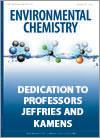
Environmental Chemistry
Volume 10 Number 3 2013
Dedication to Professors Jeffries and Kamens
EN12146Reaction of OH radicals with 5-hydroxy-2-pentanone: formation yield of 4-oxopentanal and its OH radical reaction rate constant
Environmental context. Alkanes, major constituents of vehicle exhausts, are emitted to the atmosphere where they react, chiefly by gas-phase reactions with the hydroxyl radical, to form products which can also react further. In laboratory experiments, we studied the further reactions of a model first-generation alkane reaction product. Understanding alkane reaction chains is important because the toxicity, secondary aerosol formation and other properties of vehicle emissions can change as new compounds are formed.
EN13022Why do organic aerosols exist? Understanding aerosol lifetimes using the two-dimensional volatility basis set
Environmental context. Fine particles (aerosols) containing organic compounds are central players in two important environmental issues: aerosol-climate effects and human health effects (including mortality). Although organics constitute half or more of the total fine-particle mass, their chemistry is extremely complex; of critical importance is ongoing oxidation chemistry in both the gas phase and the particle phase. Here we present a method for representing that oxidation chemistry when the actual composition of the organics is not known and show that relatively slow oxidant uptake to particles plays a key role in the very existence of organic aerosols.
EN13074Glyoxal secondary organic aerosol chemistry: effects of dilute nitrate and ammonium and support for organic radical–radical oligomer formation
Environmental context. Atmospheric waters (clouds, fogs and wet aerosols) are media in which gases can be converted into particulate matter. This work explores aqueous transformations of glyoxal, a water-soluble gas with anthropogenic and biogenic sources. Results provide new evidence in support of previously proposed chemical mechanisms. These mechanisms are beginning to be incorporated into transport models that link emissions to air pollution concentrations and behaviour.
EN13016Role of sea salt aerosols in the formation of aromatic secondary organic aerosol: yields and hygroscopic properties
Environmental context. In the coastal and ocean environment, oil spills and ship movement can produce hazardous, organic aerosols. In this study, the role of sea salt in the formation processes of crude-oil-derived organic aerosols derived was explored, and it was found that sea salt can greatly increase the formation and growth of these toxic aerosols. Understanding of this process is crucial for evaluating the effect of oil spills and ship movements on air quality and human health.
EN13025Secondary organic aerosol formation from the oxidation of a series of sesquiterpenes: α-cedrene, β-caryophyllene, α-humulene and α-farnesene with O3, OH and NO3 radicals
Environmental context. Sesquiterpenes, chemicals emitted by terrestrial vegetation, are oxidised in the ambient atmosphere leading to the formation of secondary organic aerosol. Although secondary organic aerosol can have significant effects on air quality from local to global scales, considerable gaps remain in our understanding of their various sources and formation mechanisms. We report studies on the oxidation of sesquiterpenes aimed at improving aerosol parameterisation for these reactions for incorporation into future air quality models.
EN13025 Abstract | EN13025 Full Text | EN13025PDF (1.4 MB) Open Access Article
EN13029Modelling of secondary organic aerosol formation from isoprene photooxidation chamber studies using different approaches
Environmental context. Fine particulate matter (PM2.5) in the Earth’s atmosphere plays an important role in climate change and human health, in which secondary organic aerosol (SOA) that forms from the photooxidation of volatile organic compounds (VOCs) has a significant contribution. SOA derived from isoprene, the most abundant non-methane VOC emitted into the Earth’s atmosphere, has been widely studied to interpret its formation mechanisms. However, the ability to predict isoprene SOA using current models remains difficult due to the lack of understanding of isoprene chemistry.
EN13024SO2 oxidation and nucleation studies at near-atmospheric conditions in outdoor smog chamber
Environmental context. Nucleation, a fundamental step in atmospheric new-particle formation, is a significant source of atmospheric aerosols. Most laboratory experiments investigate H2SO4 nucleation based on indoor chambers or flow tube reactors, and find discrepancies with field observations. Here a large outdoor smog chamber is used to study the relationship between SO2 and nucleation rates, and demonstrate the importance of aqueous phase oxidation of SO2 by H2O2 and other oxidants.
Environmental context. Atmospheric chlorine radicals can affect the chemical composition of the atmosphere through numerous reactions with trace species. In urban atmospheres, the reactions of chlorine radicals can lead to effects such as increases in ozone production, thus degrading local and regional air quality. This review summarises the current understanding of atmospheric chlorine chemistry in urban environments and identifies key unresolved issues.
EN13026 Abstract | EN13026 Full Text | EN13026PDF (372 KB) | EN13026Supplementary Material (659 KB) Open Access Article
EN12150Are photochemical oxidant control strategies robust to the choice of chemical mechanism?
Environmental context. Throughout the world there are many places where ozone levels are elevated above internationally accepted guidelines set to protect human health. Policy makers use air quality models to formulate emission control strategies to achieve these air quality goals for ozone. There are large uncertainties in these air quality models that mask the sensitivity of the model control strategies to chemical mechanism choice.
EN13039Evaluation of aromatic oxidation reactions in seven chemical mechanisms with an outdoor chamber
Environmental context. Regulatory air quality models used to develop strategies to reduce ozone and other pollutants must be able to accurately predict ozone produced from aromatic hydrocarbons. In urban areas, major sources of aromatic hydrocarbons are gasoline and diesel-powered vehicles. Our findings show that the representation of aromatic hydrocarbon chemistry in air quality models is an area of high uncertainty
EN13040Houston’s rapid ozone increases: preconditions and geographic origins
Environmental context. Ozone pollution in Houston, Texas, has been a public health concern for decades. Unusually large hourly changes in observed ozone concentrations have been correlated with a greater likelihood of violating the federal air quality standard. We investigate the geographic and chemical origins of these large hourly increases, which should help regulators better control ozone violations.



